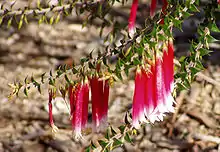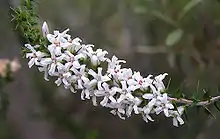Epacris
Epacris is a genus of about forty species of flowering plants in the family Ericaceae. It was formerly treated in a closely related but separate family Epacridaceae, but the various genera within Epacridaceae including Epacris have been revised in their relationships to each other and brought under the common umbrella of the Ericaceae. The genus Epacris is native to eastern and southeastern Australia (southeast Queensland south to Tasmania and west to southeast South Australia), New Caledonia and New Zealand. The species are known as heaths or Australian heaths.
| Epacris | |
|---|---|
 | |
| Epacris longiflora | |
| Scientific classification | |
| Kingdom: | Plantae |
| Clade: | Tracheophytes |
| Clade: | Angiosperms |
| Clade: | Eudicots |
| Clade: | Asterids |
| Order: | Ericales |
| Family: | Ericaceae |
| Subfamily: | Styphelioideae |
| Tribe: | Epacrideae |
| Genus: | Epacris J.R.Forst. |
| Species | |
|
See text | |
Description
Plants in the genus Epacris are shrubs with simple leaves that are a similar colour on both surfaces and with flowers arranged singly in leaf axils near the ends of the branches, sometimes extending along the branches. Each flower is surrounded by many bracts and five, usually glabrous sepals. The petals are joined to produce a cylindrical or bell-like tube with five lobes on the end. There are five stamens which are mostly enclosed in the tube, and a single style which protrudes from the tube. The fruit is a capsule.[1]
Taxonomy and naming
The genus Epacris was first formally described in 1797 by Antonio José Cavanilles, who published the description in Icones et Descriptiones Plantarum.[2] Cavanilles did not specify a type species but in 1983 Edward Groesbeck Voss nominated Epacris longiflora as the lectotype. The genus name (Epacris) is derived from an Ancient Greek word meaning "pointed at the end".[3]
Distribution
Species of Epacris are found in all Australian states except the Northern Territory and Western Australia. Two species are found in New Zealand and one in New Caledonia.[4]
Species
The following is a list of species recognised by the Australian Plant Census as at September 2019:[5]
- Epacris acuminata
- Epacris apiculata
- Epacris apsleyensis
- Epacris barbata
- Epacris breviflora
- Epacris browniae
- Epacris calvertiana
- Epacris celata
- Epacris cerasicollina
- Epacris coriacea
- Epacris corymbiflora
- Epacris crassifolia
- Epacris curtisiae
- Epacris decumbens
- Epacris exserta
- Epacris franklinii
- Epacris glabella
- Epacris glacialis
- Epacris gnidioides
- Epacris grandis
- Epacris graniticola
- Epacris gunnii - coral heath
- Epacris hamiltonii
- Epacris heteronema
- Epacris impressa - common or pink heath
- Epacris lanuginosa - woolly heath
- Epacris limbata
- Epacris lithophila
- Epacris longiflora - fuchsia heath
- Epacris marginata
- Epacris microphylla - coral heath
- Epacris moscaliana
- Epacris mucronulata
- Epacris muelleri
- Epacris myrtifolia
- Epacris navicularis
- Epacris obtusifolia - blunt-leaf heath
- Epacris paludosa - swamp heath
- Epacris petrophila
- Epacris pilosa
- Epacris pinoidea
- Epacris pulchella
- Epacris purpurascens - Port Jackson heath
- Epacris reclinata
- Epacris rhombifolia
- Epacris rigida - keeled heath
- Epacris robusta
- Epacris serpyllifolia - thyme heath
- Epacris sparsa
- Epacris sprengelioides
- Epacris stuartii
- Epacris tasmanica
- Epacris virgata
The National Herbarium of New South Wales also lists Epacris browniae,[6] Epacris muelleri[7] and Epacris rhombifolia[8] and the Royal Botanic Gardens Victoria accepts E. rhombifolia.[9]
Images


.jpg.webp) Epacris purpurascens
Epacris purpurascens
References
- Powell, Jocelyn M. "Epacris". Royal Botanic Garden Sydney. Retrieved 6 November 2017.
- "Epacris". APNI. Retrieved 6 November 2017.
- Craig, John (1854). A New Universal, Technological, Etymological, and Pronouncing Dictionary of the English Language. 1. London: George Routledge & Co. p. 645.
EPACRIS ep'-a-kris, s (epi 'upon' and akros 'the summit', Gr. in allusion to the habitation of the species on the tops of hills.) A genus of plants consisting of small and usually glabrous shrubs with axillary, white, or purplish flowers generally disposed in leafy spikes: Type of the order Epacridaceae.
- Albrecht, David E. "Epacris". Royal Botanic Gardens Victoria. Retrieved 6 November 2017.
- "Epacris". Australian Plant Census. Retrieved 15 September 2018.
- "Epacris browniae". Royal Botanic Garden Sydney. Retrieved 1 January 2018.
- "Epacris muelleri". Royal Botanic Garden Sydney. Retrieved 1 January 2018.
- "Epacris rhombifolia". Royal Botanic Garden Sydney. Retrieved 1 January 2018.
- "Epacris rhombifolia". Royal Botanic Gardens Victoria. Retrieved 1 January 2018.
| Wikimedia Commons has media related to Epacris. |
